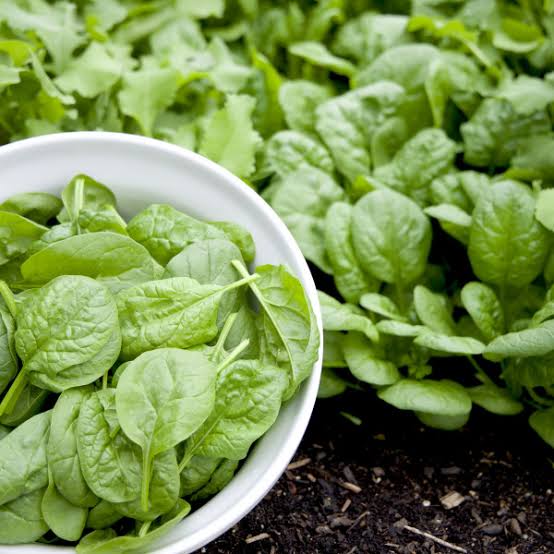Spinach is one of the most versatile and nutritious leafy greens you can grow at home. Packed with vitamins A, C, and K, along with iron and fiber, it’s a staple in salads, smoothies, and cooked dishes. The good news? Growing spinach isn’t just for expert gardeners—anyone can learn the basics and enjoy fresh leaves from their own backyard or balcony containers.In this guide, we’ll share 🔥 Top tips for how to plant spinach – simple and effective! You’ll discover the best time to sow, soil preparation techniques, watering strategies, and how to keep your spinach plants healthy all season long. Whether you’re gardening in the United States, the United Kingdom, or Canada, these strategies will help you succeed.Why Grow Spinach at Home?Before diving into the details, let’s quickly explore why spinach is a fantastic crop to grow:Fast-growing: Spinach matures quickly, often within 6–8 weeks.Nutrient-rich: It’s loaded with antioxidants, vitamins, and minerals.Cold-hardy: Unlike many leafy greens, spinach thrives in cooler temperatures.Versatile planting options: It can grow in garden beds, raised beds, or containers.With all these benefits, it’s no wonder gardeners are looking for 🔥 top tips for how to plant spinach – simple and effective!Best Time to Plant SpinachTiming for Different RegionsSpinach prefers cool weather, which means timing is everything.United States: In most states, sow seeds in early spring (as soon as the soil is workable) or late summer for a fall crop.United Kingdom: Plant outdoors from March to May, or again from August to September for autumn harvests.Canada: Similar to the UK, aim for early spring or late summer. Spinach tolerates light frost, making it a great transitional crop.👉 Tip: If summers in your area are hot, avoid planting spinach in mid-summer. High temperatures cause plants to “bolt” (go to seed), which makes the leaves bitter.Choosing the Right VarietyNot all spinach is created equal. To get the best results, select a variety suited to your climate and cooking preferences.Savoy spinach: Crinkled leaves, very cold-hardy, perfect for winter and early spring.Flat-leaf spinach: Smooth leaves, easier to clean, commonly used in salads.Semi-savoy spinach: A hybrid type that’s more disease-resistant and less prone to bolting.For those in hotter areas, consider heat-tolerant spinach varieties like Bloomsdale Long Standing or even try alternatives like New Zealand spinach (not a true spinach but great for warm weather).Preparing the SoilHealthy spinach begins with healthy soil.Soil RequirementspH range: 6.0–7.5Texture: Loose, well-draining, but moisture-retentive soilNutrients: Spinach is a “heavy feeder,” so enrich soil with compost or organic matter before planting.Practical TipsWork in 2–3 inches of compost before sowing seeds.Avoid overly sandy soil—it drains too fast, leaving spinach thirsty.In clay-heavy soils, use raised beds for better drainage.By focusing on soil health, you’ll set the stage for successful growth and enjoy the rewards of 🔥 top tips for how to plant spinach – simple and effective!Planting Spinach SeedsDirect Sowing in the GardenSow seeds ½ inch deep and about 2 inches apart.Thin seedlings to 4–6 inches apart once they sprout.Rows should be spaced 12–18 inches apart.Container PlantingSpinach grows wonderfully in pots, making it ideal for patios or balconies.Use containers at least 6–8 inches deep.Space seeds 2 inches apart, and thin seedlings as needed.Keep soil consistently moist but not soggy.👉 Pro Tip: Stagger plantings every 2–3 weeks to ensure a steady harvest of fresh leaves.Watering and MulchingSpinach needs steady moisture to thrive.Watering: Aim for about 1 inch of water per week. Keep soil evenly moist, especially during germination.Mulching: Apply a thin layer of organic mulch (like straw or shredded leaves) around plants to retain moisture, regulate soil temperature, and suppress weeds.Remember: Consistency is key. Drought stress can trigger early bolting, shortening your harvest window.Sunlight and Temperature NeedsSunlight: Spinach grows best in full sun to partial shade. In hotter climates, some afternoon shade can prevent plants from bolting.Temperature: Ideal growing range is 50–70°F (10–21°C). Below 40°F, growth slows but doesn’t stop; above 75°F, bolting is likely.Fertilizing SpinachSpinach is nutrient-hungry, especially for nitrogen, which fuels leafy growth.Apply a balanced fertilizer or a nitrogen-rich option like fish emulsion.Side-dress with compost or fertilizer every 2–3 weeks during the growing season.Avoid over-fertilizing, which can cause excessive leaf growth and reduce flavor.Common Problems and How to Solve ThemEven with careful care, spinach plants may face challenges.PestsAphids: Spray with soapy water or introduce ladybugs.Leaf miners: Remove damaged leaves and cover plants with row covers.Slugs/snails: Hand-pick or use slug traps.DiseasesDowny mildew: Choose resistant varieties and avoid overhead watering.Fusarium wilt: Rotate crops and avoid planting spinach in the same spot each year.By addressing these issues early, you’ll keep your spinach crop lush and thriving.Harvesting SpinachHarvesting spinach correctly ensures a long-lasting crop.Baby leaves: Ready in 3–4 weeks after planting. Simply snip outer leaves.Mature leaves: Harvest after 6–8 weeks, cutting leaves 1 inch above the crown.Continuous harvest: Pick outer leaves regularly, leaving the center to grow.👉 Tip: If plants start to bolt, harvest immediately for the best flavor.Practical Tips for SuccessHere’s a quick recap of 🔥 top tips for how to plant spinach – simple and effective!Plant in cool weather for best results.Choose the right variety for your climate.Enrich soil with organic matter before planting.Keep soil consistently moist and use mulch.Thin seedlings to avoid overcrowding.Protect against pests with natural methods.Harvest leaves regularly to encourage new growth.These straightforward strategies will maximize your spinach harvest, whether you’re a beginner or seasoned gardener.ConclusionGrowing spinach doesn’t have to be complicated. By following these 🔥 top tips for how to plant spinach – simple and effective!, you’ll enjoy a steady supply of fresh, healthy greens right from your own garden or balcony. With the right soil, timing, and care, spinach rewards you with nutrient-packed leaves that elevate your meals and support your health.Whether you’re in the United States, the United Kingdom, or Canada, these guidelines give you everything you need to succeed. Start small, stay consistent, and soon you’ll wonder why you ever bought spinach at the store

